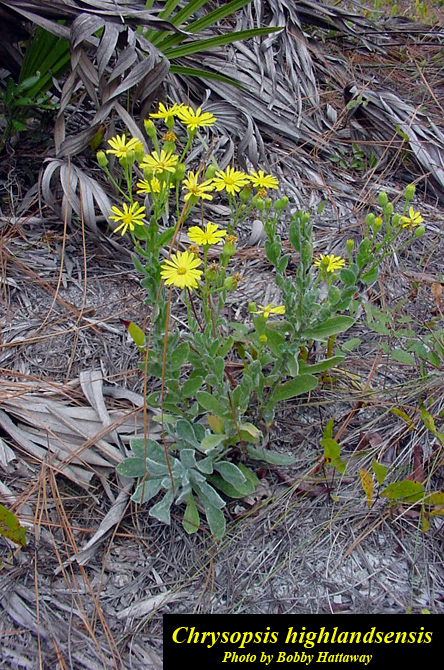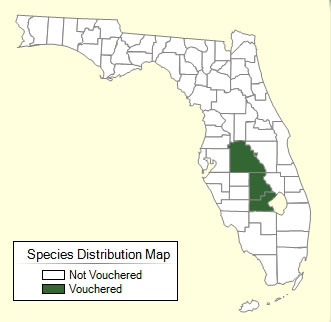Chrysopsis highlandsensis
| Chrysopsis highlandsensis | |
|---|---|

| |
| Photo by Bobby Hattaway, Atlas of Florida Vascular Plants | |
| Scientific classification | |
| Kingdom: | Plantae |
| Division: | Magnoliophyta - Flowering plants |
| Class: | Magnoliopsida – Dicotyledons |
| Order: | Asterales |
| Family: | Asteraceae ⁄ Compositae |
| Genus: | Chrysopsis |
| Species: | C. highlandsensis |
| Binomial name | |
| Chrysopsis highlandsensis DeLaney & Wunderlin | |

| |
| Natural range of Chrysopsis highlandsensis from Atlas of Florida Vascular Plants. | |
Common name: Highlands goldenaster
Contents
Taxonomic notes
Synonyms: none.[1]
Varieties: none.[1]
Description
C. highlandsensis is a perennial species with a short taproot and a basal rosette that shoots up a lanate flowering stem.[2]
Distribution
It is endemic to central peninsular Florida.[3]
Ecology
Habitat
Endemic to the Lake Wales Ridge, C. highlandsensis is found in sand pine scrubs, scrubby flatwoods, and turkey oak/longleaf communities.[2][4] This species has been found in historically and chronically disturbed habitats like highway medians,[4] [5] and has been observed to have a high survival rate after hurricanes.[6]
Associated species include Lechea cernua, Polygonella basiramia, Selaginella arenicola, and Liatris tenuifolia.[4]
Phenology
It is a semelparous species, usually flowering the third year of life. Yellow composite flowers appear November and December.[2]
Seed dispersal
The fruit is a composite achene with a pappus modified for wind dispersal.[2]
Seed bank and germination
It has been found to divide by rhizomes, tubers, corms, and bulbs.[7] It has been observed to produce a limited persistent soil seed bank.[2]
Pollination
Chrysopsis highlandsensis has been observed at the Archbold Biological Station to host ground-nesting bees such as Andrena fulvipennis (family Andrenidae), bees such as Bombus impatiens (family Apidae), sweat bees from the Halictidae family such as Agapostemon splendens, Lasioglossum miniatulus and Lasioglossum nymphalis, and leafcutting bees from the Megachilidae family such as Megachile brevis pseudobrevis and Megachile mendica.[8]
Conservation, cultivation, and restoration
Global Conservation Status: G2.[9]
Cultural use
Photo Gallery
References and notes
- ↑ 1.0 1.1 Weakley, A.S. 2015. Flora of the southern and mid-atlantic states. Working Draft of 21 May 2015. University of North Carolina at Chapel Hill, Chapel Hill, North Carolina.
- ↑ 2.0 2.1 2.2 2.3 2.4 [Archbold Biological Station]Accessed: December 4, 2015
- ↑ Weakley, Alan S. Flora of the Southern and Mid-Atlantic States: Working Draft of 21 May 2015. University of North Carolina Herbarium (NCU). PDF. 1102.
- ↑ 4.0 4.1 4.2 [University of Florida Herbarium]Accessed: December 4, 2015
- ↑ University of Florida Herbarium Database. URL: https://www.floridamuseum.ufl.edu/herbarium. Last accessed: May 2021. Collectors: Anne Cox and Heather Loring. States and counties: Florida: Polk.
- ↑ Menges, E. S., C. W. Weekley, et al. (2011). "Effects of Hurricanes on Rare Plant Demography in Fire-Controlled Ecosystems." Biotropica 43(4): 450-458.
- ↑ [Dave's Garden]Accessed: December 4, 2015
- ↑ Deyrup, M.A. 2015. Database of observations of Hymenoptera visitations to flowering plants on Archbold Biological Station, Florida, USA.
- ↑ [NatureServe]Accessed: December 4, 2015